- Clone
- G043H7 (See other available formats)
- Regulatory Status
- RUO
- Other Names
- BLR2, CDw197, EBI1, CMKBR7
- Isotype
- Mouse IgG2a, κ
- Ave. Rating
- Submit a Review
- Product Citations
- publications
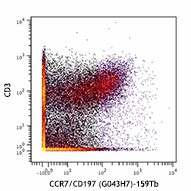
-

Human PBMCs stained with 170Er-anti-CD3 (UCHT1) and 159Tb-anti-CD197 (G043H7). Lymphocytes are displayed in the analysis. Data provided by DVS Sciences.
| Cat # | Size | Price | Quantity Check Availability | Save | ||
|---|---|---|---|---|---|---|
| 353237 | 100 µg | 156€ | ||||
CCR7, also known as CD197, is a chemokine receptor that binds CCL19 and CCL21. CCR7 and its ligands link innate and adaptive immunity by affecting interactions between T cells and dendritic cells and their downstream effect. Naïve T cells enter the lymph node through high endothelial venules, which express CCL21. Dendritic cells and macrophages enter the lymph node through afferent lymphatics. The encounter of T cells and dendritic cells in the T cell zone is CCR7-dependent. In addition, during immunological surveillance, B cells recirculate between B-cell-rich compartments (follicles or B cell zones) in secondary lymphoid organs, surveying for antigen. After antigen binding, B cells move to the boundary of B and T zones to interact with T-helper cells; this B cell migration is directed by CCR7 and its ligands. CCR7-positive cancer cell expression has been associated with lymph node metastasis.
Product DetailsProduct Details
- Verified Reactivity
- Human
- Reported Reactivity
- African Green, Baboon, Cynomolgus, Rhesus
- Antibody Type
- Monoclonal
- Host Species
- Mouse
- Immunogen
- CCR7-transfected cells
- Formulation
- Phosphate-buffered solution, pH 7.2, containing 0.09% sodium azide and EDTA.
- Preparation
- The antibody was purified by affinity chromatography.
- Concentration
- 1.0 mg/ml
- Storage & Handling
- The antibody solution should be stored undiluted between 2°C and 8°C.
- Application
-
FC - Quality tested
CyTOF® - Verified - Recommended Usage
-
This product is suitable for use with the Maxpar® Metal Labeling Kits. For metal labeling using Maxpar® Ready antibodies, proceed directly to the step to Partially Reduce the Antibody by adding 100 µl of Maxpar® Ready antibody to 100 µl of 4 mM TCEP-R in a 50 kDa filter and continue with the protocol. Always refer to the latest version of Maxpar® User Guide when conjugating Maxpar® Ready antibodies.
- Additional Product Notes
-
Maxpar® is a registered trademark of Standard BioTools Inc.
- Product Citations
-
- RRID
-
AB_2563726 (BioLegend Cat. No. 353237)
Antigen Details
- Structure
- Chemokine receptor, G protein-coupled receptors (GPCR), seven transmembrane receptor.
- Distribution
-
T cells, B cells, NK, dendritic cells.
- Function
- The chemokine receptor CCR7 plays a pivotal role in the homing of naïve T cells and regulatory T cells to secondary lymphoid organs, and the migration of dendritic cells into afferent lymphatic vessels.
- Ligand/Receptor
- CCL19 and CCL21.
- Cell Type
- B cells, Dendritic cells, NK cells, T cells
- Biology Area
- Immunology
- Molecular Family
- CD Molecules, Cytokine/Chemokine Receptors, GPCR
- Antigen References
-
1. Yanagihara S, et al. 1998. J. Immunol. 161:3096.
2. Charo IF, et al. 2006. N. Engl. J. Med. 354:610.
3. Reif K, et al. 2002. Nature 416:94.
4. Nakata B, et al. 2008. Oncology 74:69.
5. Brodie T. et al. 2013. Cytometry A. 6: 530-2. PubMed
6. Graves A.J. et al. 2014. Cytometry A. 7: 576–9 PubMed
7. Moncunill G. et al. 2014. Cytometry A. 12: 995-8 PubMed - Gene ID
- 1236 View all products for this Gene ID
- UniProt
- View information about CD197 on UniProt.org
Related FAQs
- Does staining at room temperature or even at 37°C help for checking chemokine receptors expression?
-
Due to continuous recycling of many chemokine receptors, it may be worthwhile to consider staining at room temperature or at 37°C if the staining at lower temperature (which can potentially reduce receptor turnover) is not optimal.
- Can I obtain CyTOF data related to your Maxpar® Ready antibody clones?
-
We do not test our antibodies by mass cytometry or on a CyTOF machine in-house. The data displayed on our website is provided by Fluidigm®. Please contact Fluidigm® directly for additional data and further details.
- Can I use Maxpar® Ready format clones for flow cytometry staining?
-
We have not tested the Maxpar® Ready antibodies formulated in solution containing EDTA for flow cytometry staining. While it is likely that this will work in majority of the situations, it is best to use the non-EDTA formulated version of the same clone for flow cytometry testing. The presence of EDTA in some situations might negatively affect staining.
- I am having difficulty observing a signal after conjugating a metal tag to your Maxpar® antibody. Please help troubleshoot.
-
We only supply the antibody and not test that in house. Please contact Fluidigm® directly for troubleshooting advice: http://techsupport.fluidigm.com/
- Is there a difference between buffer formulations related to Maxpar® Ready and purified format antibodies?
-
The Maxpar® Ready format antibody clones are formulated in Phosphate-buffered solution, pH 7.2, containing 0.09% sodium azide and EDTA. The regular purified format clones are formulated in solution that does not contain any EDTA. Both formulations are however without any extra carrier proteins.
Other Formats
View All CD197 Reagents Request Custom ConjugationCustomers Also Purchased
Compare Data Across All Formats
This data display is provided for general comparisons between formats.
Your actual data may vary due to variations in samples, target cells, instruments and their settings, staining conditions, and other factors.
If you need assistance with selecting the best format contact our expert technical support team.
-
Purified anti-human CD197 (CCR7)

Human peripheral blood lymphocytes were stained with purifie... -
Alexa Fluor® 488 anti-human CD197 (CCR7)
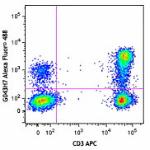
Human peripheral blood lymphocytes were stained with CD3 APC... 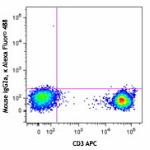
-
Brilliant Violet 421™ anti-human CD197 (CCR7)
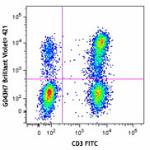
Human peripheral blood lymphocytes were stained with CD3 FIT... 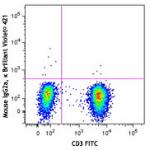
-
PE anti-human CD197 (CCR7)
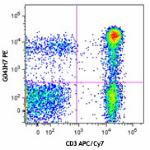
Human peripheral blood lymphocytes were stained with CD3 APC... 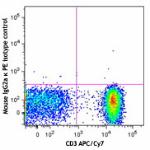
-
APC/Cyanine7 anti-human CD197 (CCR7)

Human peripheral blood lymphocytes were stained with CD3 FIT... -
Pacific Blue™ anti-human CD197 (CCR7)
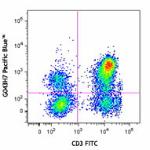
Human peripheral blood lymphocytes were stained with CD197 (... 
-
APC anti-human CD197 (CCR7)
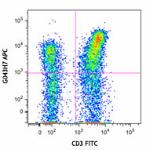
Human peripheral blood lymphocytes were stained with CD3 FIT... 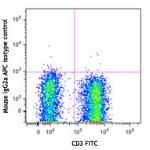

APC anti-human CD197 (CCR7) Antibody Cynomolgus monkey peri... 
Rhesus macaque peripheral blood lymphocytes were stained wit... -
FITC anti-human CD197 (CCR7)

Human peripheral blood lymphocytes were stained with CD3 APC... 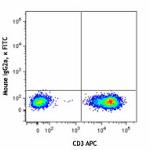
-
Alexa Fluor® 647 anti-human CD197 (CCR7)
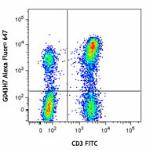
Human peripheral blood lymphocytes were stained with CD3 FIT... 
-
PerCP/Cyanine5.5 anti-human CD197 (CCR7)

Human peripheral blood leucocytes were stained with CD3 FITC... -
Brilliant Violet 605™ anti-human CD197 (CCR7)
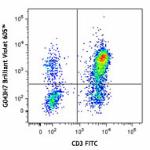
Human peripheral blood lymphocytes were stained with CD3 FIT... -
PE/Cyanine7 anti-human CD197 (CCR7)

Human peripheral blood lymphocytes were stained with CD3 FIT... -
Brilliant Violet 711™ anti-human CD197 (CCR7)
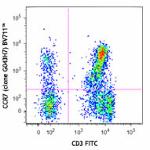
Human peripheral blood lymphocytes were stained with CD3 FIT... -
Brilliant Violet 785™ anti-human CD197 (CCR7)

Human peripheral blood lymphocytes were stained with CD3 FIT... -
Brilliant Violet 510™ anti-human CD197 (CCR7)
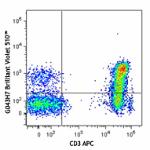
Human peripheral blood lymphocytes were stained with CD3 APC... 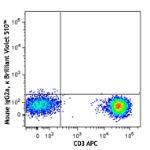
-
Brilliant Violet 650™ anti-human CD197 (CCR7)
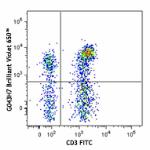
Human peripheral blood lymphocytes were stained with CD3 FIT... 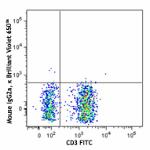
-
PE/Dazzle™ 594 anti-human CD197 (CCR7)
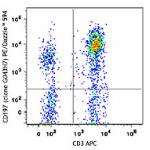
Human peripheral blood lymphocytes were stained with CD3 APC... 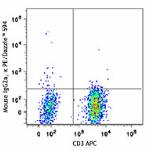
-
Biotin anti-human CD197 (CCR7)

Human peripheral blood lymphocytes were stained with biotiny... -
Purified anti-human CD197 (CCR7) (Maxpar® Ready)

Human PBMCs stained with 170Er-anti-CD3 (UCHT1) and 159Tb-an... -
PerCP anti-human CD197 (CCR7)

Human peripheral blood lymphocytes were stained with CD3 FIT... 
-
Alexa Fluor® 700 anti-human CD197 (CCR7)

Human peripheral blood lymphocytes were stained with CD3 FIT... 
-
APC/Fire™ 750 anti-human CD197 (CCR7)

Human peripheral blood lymphocytes were stained with CD3 FIT... -
TotalSeq™-A0148 anti-human CD197 (CCR7)
-
TotalSeq™-B0148 anti-human CD197 (CCR7)
-
TotalSeq™-C0148 anti-human CD197 (CCR7)
-
Brilliant Violet 750™ anti-human CD197 (CCR7)

Human peripheral blood lymphocytes were stained with CD3 FIT... -
Ultra-LEAF™ Purified anti-human CD197 (CCR7)

Chemotaxis of human CCR7-transfected BaF3 cells was performe... -
Spark NIR™ 685 anti-human CD197 (CCR7)

Human peripheral blood lymphocytes were stained with CD3 FIT... -
KIRAVIA Blue 520™ anti-human CD197 (CCR7)

Human peripheral blood lymphocytes were stained with CD3 APC... -
PE/Fire™ 640 anti-human CD197 (CCR7)

Human peripheral blood lymphocytes were stained with CD3 FIT... -
Spark YG™ 581 anti-human CD197 (CCR7)

Human peripheral blood lymphocytes were stained with anti-hu... -
APC/Fire™ 810 anti-human CD197 (CCR7) Antibody

Human peripheral blood lymphocytes were stained with anti-hu... -
TotalSeq™-D0148 anti-human CD197 (CCR7)
-
PE/Fire™ 810 anti-human CD197 (CCR7) Antibody

Human peripheral blood lymphocytes were stained with anti-hu... -
PE/Cyanine5 anti-human CD197 (CCR7)

Human peripheral blood lymphocytes were stained with CD3 FIT... -
Spark YG™ 593 anti-human CD197 (CCR7)

Human peripheral blood lymphocytes were stained with anti-hu... -
PE/Fire™ 744 anti-human CD197 (CCR7)

Human peripheral blood lymphocytes were stained with anti-hu... -
Spark Red™ 718 anti-human CD197 (CCR7) (Flexi-Fluor™)
 Login / Register
Login / Register 










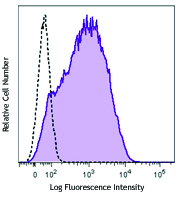
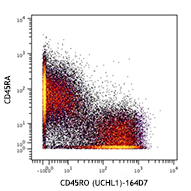
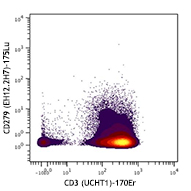
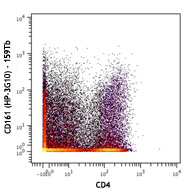



Follow Us